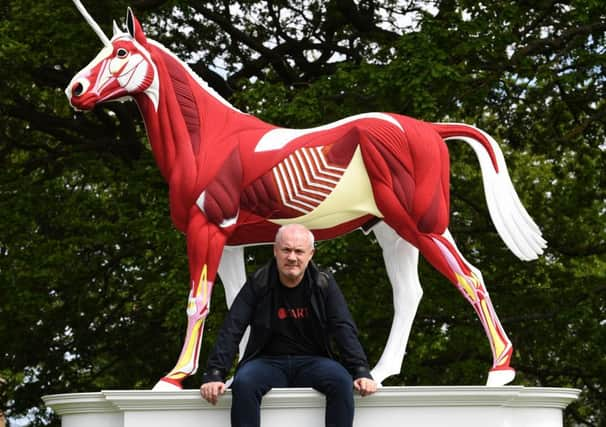Exclusive: Boy with a barrel that awakened Damien Hirst to outdoor art


The statue of a boy with a barrel, produced by an anonymous artist and placed outside Lewis’s department store in Leeds when he was 15, was the first outdoor sculpture he had seen.
Yesterday, as he prepared to unveil two of his own large scale works just around the corner, he took stock of its impact.
Advertisement
Hide AdAdvertisement
Hide AdOne of the outrageous young Brits who dominated the art world in the 1990s, Hirst had grown up in Leeds, taking in the Francis Bacons and Peter Blakes at the city free art gallery, to which his mum would take him when he tired of following her around the shops.
Later, as an aspiring punk rocker, wearing shocking clothes under his school uniform but too young to actually go to a concert, the city centre was his playground.
“The guy with the barrel was where everyone met when I was growing up,” he told The Yorkshire Post. “It’s a really strong memory. It was the first outdoor sculpture I ever saw.”
The artwork is still there, beside a kiosk in the square named after Leeds’ twin city.
Advertisement
Hide AdAdvertisement
Hide Ad“I don’t know the name of the artist – it just appeared one day,” Hirst said. “It’s so great to think that everything’s changing, but that’s still there.
“That’s the that’s the power and the wonder of outdoor sculptures.
“You put a painting in an art gallery, some rich guy buys it, and it’s gone. But with an outdoor sculpture, you can have a huge effect on a whole town.”
Hirst will exhibit two of his best-known works – Hymn and Anatomy of an Angel – outdoors in Leeds city centre all summer long, as part the first Yorkshire Sculpture International festival. One of his animals-in-formaldehyde series, Black Sheep with Golden Horns, will be inside the art gallery.
Advertisement
Hide AdAdvertisement
Hide AdYesterday, though, he was at the Yorkshire Sculpture Park at Wakefield, in whose magnificent countryside setting four of his other outdoor works are already in place.
It is the first time he has exhibited there. “You neglect where you come from, don’t you? Too busy going off to New York doing shows,” he said.
But he needed no persuasion to be one of the star attractions at the festival, which opens on June 22 and also takes in The Hepworth Wakefield and the Henry Moore Gallery in Leeds.
“I like doing things up North,” he said.
Despite acknowledging his rebellious nature, he speaks fondly of his Yorkshire childhood.
Advertisement
Hide AdAdvertisement
Hide Ad“ I loved growing up in Leeds. I mean, we didn’t have a lot of money, so it was difficult at times. But my life there was brilliant.
“My dad sold cars, and he’d let me get some mates together and get a car and take us to Otley Chevin or Adel Crag and do nature-y things.”
He also had a first brush with fame, of sorts, when the Yorkshire Evening Post took a picture of a class project at his school.
“I remember mum showing it to the neighbours. ‘Damien’s in the paper’, she said. It was a little taste of being famous.”
Advertisement
Hide AdAdvertisement
Hide AdHis celebrity now is less ephemeral. He is the country’s richest living artist, with a reported wealth of £215m. But his aptitude for art was slow to develop, and he got an E grade at A-Level.
“But an E was almost as good as an A, in those days, as long as had a lot of good art to back it up,” he said.
He also says his tastes in his Yorkshire days, at what was then the Jacob Kramer College, were old fashioned, and that he was “a bit shocked” by the contemporary art he saw when he eventually got to Goldsmiths College in London.
He regarded the sexual content of paintings by the American Jeff Koons as “not art”, but added: “I ended up buying them five years later.”
Advertisement
Hide AdAdvertisement
Hide AdIt was Freeze, the student show he organised at Goldsmiths in 1988, in a disused warehouse, that attracted the attention of patrons like Charles Saatchi and forged his reputation as an enfant terrible of the art world.
Now, at 53, he is part of the establishment, though he does not credit it with giving him much help on the way up.
“I won the Turner Prize, so I guess at that point I became establishment,” he said. “The first time I was nominated, I didn’t get it. Usually when I’m getting judged on other people’s terms, it doesn’t go very well.”